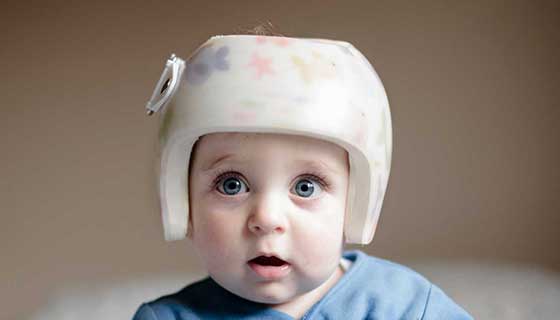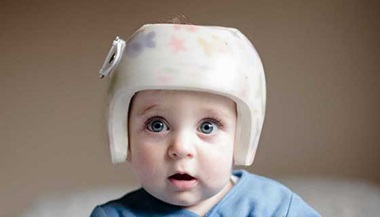Microcephaly
Microcephaly is a rare condition in which a baby’s or child’s head is much smaller than typical for their age.
What You Need to Know
- Microcephaly is defined by head circumference, a measurement taken by a pediatrician during health care visits.
- Microcephaly is rare in the United States, affecting only one of 800 to 5,000 babies and children.
- It occurs most often as a result of the brain failing to grow at a normal rate, either before birth or during early infancy or childhood.
- Surgery can address microcephaly that is caused by craniosynostosis.
What is microcephaly?
Microcephaly is a condition in which a baby’s head is much smaller than expected for the baby’s age. This could be due to the brain not developing properly either during pregnancy or after birth up to the first few years of life.
Microcephaly is a rare condition that can be a symptom of several disorders. It affects only one out of every 800 to 5,000 babies and children in the U.S.
Children with microcephaly generally have differing degrees of intellectual disability, though a small percentage will not experience any developmental delays. Children with this condition may also have delayed speech and motor functions, dwarfism or short stature, vision and hearing deficiencies, and/or other problems associated with neurological abnormalities.
Not every child or adult with a smaller-than-average head meets the measurement criteria for microcephaly.
Types of Microcephaly
Congenital microcephaly is present at birth or seen on a sonogram within 36 weeks of pregnancy.
Postnatal microcephaly develops after birth, when the head does not grow at an expected rate. This type, also called secondary microcephaly, can be caused by damage to a child’s brain.
Isolated microcephaly is when a small head and brain size are the only signs.
Syndromic microcephaly is small head and brain size associated with one of many genetic syndromes that can include other symptoms.
Microcephaly Symptoms
Symptoms of microcephaly include:
- A small head
- A small brain
Depending on the cause, children with microcephaly generally have differing degrees of intellectual ability, though a small percentage of children diagnosed with microcephaly will not experience any developmental delays.
More severe microcephaly is linked to more serious associated problems, which can be permanent. The problems include:
- Seizures
- Delayed speech
- Decreased ability to learn
- Difficulty with movement and balance
- Problems with feeding, eating and swallowing
- Metabolic disorders
- Dwarfism or short stature
- Vision and hearing problems
- Neurological abnormalities such as neural tube defects
Microcephaly Diagnosis
Fetal ultrasound can assess the head size of a growing fetus and detect microcephaly in the second trimester of pregnancy.
When the baby is born, a measurement of head size — occipital frontal circumference (OFC) — can diagnose microcephaly. A health care practitioner uses a flexible tape to measure the child’s head over the ridge of the eyebrows and around the back of the skull. A calculator helps determine if the child’s OFC is in a range that indicates borderline, moderate or severe microcephaly.
The child’s health care practitioner may examine the head and fontanelles (gaps between the plates of a baby’s skull) for signs of craniosynostosis — the premature closure of one or more joint between the bones of the skull before brain growth is complete.
If the child’s OFC measurement meets the definition of microcephaly, other tests such as a physical exam or MRI can examine the brain and identify other problems that could indicate a genetic syndrome or other cause.
What causes microcephaly?
Often, the reason is unknown: In about 41% of subjects in a study of 680 children with microcephaly, the cause could not be determined.
Some instances of microcephaly are caused by damage to the brain either in a developing fetus or in an infant or child, due to the following.
- Genetic abnormalities and genetic syndromes
- Brain injury before birth due to maternal:
- Lack of blood flow
- Stroke or hemorrhage
- Complications during labor and delivery
- Severe malnutrition after birth
Treatment of Microcephaly
Babies with microcephaly due to craniosynostosis may be able to be treated with surgery and helmet therapy to re-shape the skull and allow room for brain development. However, microcephaly due to other causes is a lifelong condition.
Mild microcephalic conditions may not require special treatment. If the only concern is a smaller than expected head size, the child’s health practitioner may keep track of head measurements to assess brain and skull development as the child grows.
Children born with moderate or severe microcephaly who develop symptoms may benefit from physical therapy and other early interventions that can address problems and maximize motor and brain development. Motor and learning challenges may be permanent. Medications may address seizures or other symptoms.
Life Expectancy with Microcephaly
The life expectancy of children born with microcephaly depends on the degree of the problem and other medical problems affecting the child. When microcephaly is severe, the health problems associated with the condition can shorten the life span.




